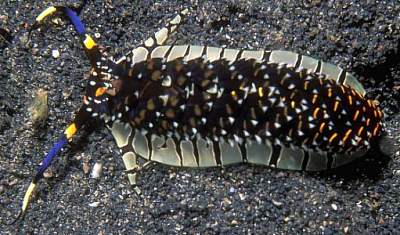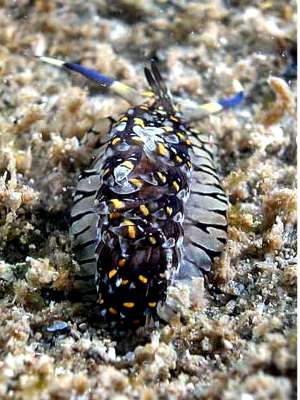

Cerberilla ambonensis
Bergh, 1905
Order: NUDIBRANCHIA
Suborder: AEOLIDINA
Family: Aeolidiidae
DISTRIBUTION
Western Pacific and Indonesian Archipelago.
PHOTO
UPPER: Sulawesi, Indonesia. Length: 5cm, Depth: 12m., 12 July 2003. Photo: Giorgio Berger.
LOWER: Plate V, fig 6. Bergh, 1905.
The most characteristic external feature of this species would appear to be the transverse dark lines across the foot, which can be seen in Bergh's illustration. I have another photo clearly showing the ceratal colour of another specimen from Darwin but unfortunately can not get permission to use the photo. In that photo the cerata are black with broad yellow band some distance from the tip, then a black band, then a bluish white cap. The basal half of the longest cerata is greyish brown then black. The black band between the yellow and the white terminal region can be thin, broad or absent. The oral tentacles are white at the base then have a broad blue band filling the middle half of the tentacle, then a short black band, then white tip. In both Bergh's illustration and Scott Johnson's photo, the whitish terminal part of each cerata is absent or not very obvious. In Cerberilla annulata which also has yellow and black ceratal bands, the yellow and black are in reverse order.
Reference:
• Bergh, L.S.R. (1905). Die Opisthobranchiata der Siboga-Expedition. Monographie 50: 1-248, pls. 1-20
Rudman, W.B., 1999 (November 29) Cerberilla ambonensis Bergh, 1905. [In] Sea Slug Forum. Australian Museum, Sydney. Available from http://www.seaslugforum.net/find/cerbambo
Related messages
Cerberilla ambonensis from New South Wales
March 26, 2010
From: Leanne and David Atkinson


Concerning message #12504:
Hi Bill,
Dive buddy Rob Wallis found this nudibranch which we think is Cerberilla ambonensis. This is the first time we have seen it at Port Stephens. It was moving quickly across the sand in strong current during daylight hours on a bright sunny day but poor visability of only a few metres made it darker and we were using torches to assist finding photographic subjects.The water temperature was 22 degrees celcius. Hope this is of interest.
Locality: Seahorse Gardens, Nelson Bay Beach, Port Stephens, 8metres, New South Wales, Australia, Pacific Ocean, 21 March 2010, Sandy bottom with scattered sponges, bryozoans, ascidians, soft corals, Sea Pens and gorgonians. Length: 30mm approximately. Photographer: Leanne and David Atkinson.
Leanne & David Atkinson
atk@hunterlink.net.au
Atkinson, L. & D., 2010 (Mar 26) Cerberilla ambonensis from New South Wales. [Message in] Sea Slug Forum. Australian Museum, Sydney. Available from http://www.seaslugforum.net/find/23379
Dear Leanne and David,
This find certainly helps increase the known range of this species. It is a nice find.
Best wishes,
Bill Rudman
Burrowing in Cerberilla ambonensis
March 24, 2004
From: Gary Cobb

Hi Bill,
I have been observing Cerberilla ambonensis and photographing it as well. This aeolid is really interesting to watch. It burrows into the sand and actually turns around and peers out before hiding again. I have attached some photos that might be of interest to you and the other branchers. The animal was collected in 2m of water off the Mooloolaba rock wall on Saturday crawling on sand. [Mooloolaba, Sunshine Coast. Queensland, Australia, March 2004]. It was 13mm long.
[see earlier messages #12501, #12503].
Enjoy
Gary Cobb
gary@cobb.com.au


Dear Gary,
Were these and the earlier photos taken on the same occasion or have you been able to refind the animal? Your observation that it turns in its 'burrow' is certainly interesting, suggesting that it is perhaps just 'hiding' in a hole rather than using underground burrowing as its normal method of moving around.
Best wishes
Bill Rudman
Re: Cerberilla ambonensis found Sthn Queensland
March 23, 2004
From: Gary Cobb

Concerning message #12501
Hi Bill,
The size of this Cerberilla ambonensis was 13 mm in length while crawling.
The burrowing photos in message #12504 were shot in the studio, I wanted to really observe this beautiful animal as much as possible without surge and silt.
The burrowing in #12501 and the crawling shots were as I found the animal. In particular the burrowing shot, as I was shooting it it started to disappear so I very quickly unburyed it and decided to bring it to the studio. I set up a 3 inch deep glass dish with about 30mm of sand and on top of that 30mm of salt water and let the animal go.
I shot some video footage of the burrowing and crawling behaviors as well (for free viewing!). It can be viewed on my website where I am recording all the species of nudibranchs here on the Sunshine Coast Southern Queenland Australia. http://www.cobb.com.au The total to date is 94. If you click on the Collection and go to page 6 there are the latest photos. There is also a species list with locations and orrcurances as well as maps. Since I am an artist as well I started to paint nudibranchs too. More coming! There is a NudiArt section.
This animal was very active in the black dish and I really had to chase it to get shots. Can you tell me exactly what kind of dish you use and where you got it? Do you have a photo of it. Do you have a set up of your camera and system as well? I am always looking for better ways to record the animals as best as I can.
In regards to the storm you may be on something there...the low light may have brought this little one out to forage. Richard Willan suggested I dig around the immediate area where there could be more lurking!
Thanks for all your help, I will be revisiting the area and checking to see if more are there. Also attached is a map of the Mooloolaba rock wall and where I found this animal
Cheers
Gary
gary@ cobb.com.au
Cobb, G., 2004 (Mar 23) Re: Cerberilla ambonensis found Sthn Queensland. [Message in] Sea Slug Forum. Australian Museum, Sydney. Available from http://www.seaslugforum.net/find/12524Cerberilla ambonensis found Sthn Queensland
March 23, 2004
From: Gary Cobb

Hi Bill,
Please find attached some photos of Cerberilla ambonensis I found while diving just before a storm at the Mooloolaba Rock wall on a 2m deep sandy area in front of a ledge system the runs perpendicular to the wall [Mooloolaba, Sunshine Coast. Queensland, Australia, March 2004]. The animal was found crawling, very quickly for a nudibranch, on sand. I took photos of it on silty sand where it buried itself. What a beautiful animal! Are these common here on the Coast?
Cheers,
Gary Cobb
gary@cobb.com.au


Thanks Gary,
They are spectacular animals. Can you give us an indication of its size please? I'm afraid we know very little about most species because they spend most of their time burrowing through the sand. It is possible they are nocturnal, appearing only at night, but I know of no evidence for that. You mention seeing it just before a storm. If it was cloudy and overcast then it may have emerged from the sand because light levels were low?
I wonder why such spectacularly coloured animals spend their life where they can't be seen?
Best wishes
Bill Rudman
Cerberilla ambonensis found Sthn Queensland
March 23, 2004
From: Gary Cobb


Hi Bill,
I thought you might like these two photos of Cerberilla ambonensis from the weekend. I sent you some photos earlier while diving [message #12501].
[Mooloolaba, Sunshine Coast. Queensland, Australia, March 2004].
Cheers,
Gary Cobb
gary@cobb.com.au
Cobb, G., 2004 (Mar 23) Cerberilla ambonensis found Sthn Queensland. [Message in] Sea Slug Forum. Australian Museum, Sydney. Available from http://www.seaslugforum.net/find/12503Thanks Gary,
It's interesting to see how 'shape' changes when these animals are photographed on a smooth hard surface. If you compare these photos with your in situ photos in the earlier message, you will see that the foot extends much further in the natural environment. I use 'glass-dish' photography a lot to get clean uncluttered backgrounds, but, particularly with species which normally live on mud or soft sand, they are obviously not fully 'at home' in a dish
Best wishes
Bill Rudman
Cerberilla ambonensis from the Solomon Ids
January 8, 2004
From: Bruce Potter

Dear Bill,
Happy New Year.
I found this slug on New Years Day at the dive site "Bonegi 1" just near Honiara on Guadalcanal, Solomon Islands.
It was crawling over sand at about 14 meters. It was about 35mm long. At one stage I moved it and was interested to note that it curled up into a ball much like an armadillo would.
Would I be correct in identifying it as a Cerberilla ambonensis .
Regards
Bruce Potter
bac@solomon.com.sb
Potter, B., 2004 (Jan 8) Cerberilla ambonensis from the Solomon Ids. [Message in] Sea Slug Forum. Australian Museum, Sydney. Available from http://www.seaslugforum.net/find/11803
Thanks Bruce,
May all your finds in 2004 be this interesting. It is indeed what I have been calling Cerberilla ambonensis. It seems more colourful than in Bergh's original illustration but it appears that in some animals of this species the colours can be quite dull. I think Cerberilla ambonensis is the only species with dark tranverse lines on the foot.
One problem with species of Cerberilla is that they normally live buried in, or burrowing through, soft sediments and so are seldom found. It is therefore difficult to get much of an idea of how much variation we can expect to find in their colour patern.
Best wishes
Bill Rudman
Cerberilla ambonensis? from Indonesia
August 15, 2003
From: Erwin Köhler


Dear Bill,
The foot of this one looks similar to the photo of Scott Johnson's from the Solomon Islands, which you identified as Cerberilla ambonensis but the oral tentacles look pretty different. Any idea?
This shot is by Giorgio Berger (email: incocnito@hotmail.com), taken at Sulawesi, Indonesia.
length: 5cm
depth: 12m
date: 12 July 2003
Regards,
Erwin
Erwin@Philippine-Sea-Slugs.com
Köhler, E., 2003 (Aug 15) Cerberilla ambonensis? from Indonesia. [Message in] Sea Slug Forum. Australian Museum, Sydney. Available from http://www.seaslugforum.net/find/10732Thanks Erwin,
Actually Giorgio's photo makes me much more comfortable with my tentative identification of Scott Johnson's photo. Although the oral tentacles in Giorgio's photo are much more brightly coloured, the yellow patches match Scott's photo as does the blue region. Giorgio's photo also shows many of the features in the colour painting in Bergh (1905) - in particular the extremely long tentacular processes extending from the anterior corners of the foot and the ceratal colour pattern, consisting of a white tip, a subterminal black band then a yellow band.
So my feeling is that the similarities outweigh the differences and this is Cerberilla ambonensis
Best wishes,
Bill Rudman
Cerberilla ambonensis? from the Solomon Is.
December 1, 1999
From: Scott Johnson

Hi Bill,
Here's the promised scan of Cerberilla sp from Guadalcanal, Solomon Islands. This animal was found crawling on the surface of the sand at night, and I think it measured around 50mm.
Scott
johnson@kmr.ll.mit.edu
Johnson, S., 1999 (Dec 1) Cerberilla ambonensis? from the Solomon Is.. [Message in] Sea Slug Forum. Australian Museum, Sydney. Available from http://www.seaslugforum.net/find/1616Dear Scott,
Thanks for the photo. I think this is probably Cerberilla ambonensis, but we need more material to be sure just what that species is. I suspect the dark grey or black transverse lines on the foot are the most useful external character but I guess only time will tell.
Best wishes,
Bill Rudman.
